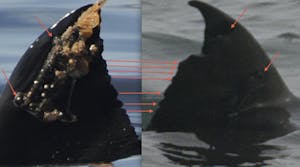How to Identify an Individual Great White Shark. Part 1

There are two different approaches to identifying an individual Great White shark. Part 1
Part 1 and discussed here is by using a Dorsal Fin ID photo, we use this method at the Farallon Islands.
Since 2004 I have been keeping a collection of identifying photos of Great White sharks. I have submitted and offered these to the researchers of the Farallon Islands, Guadalupe, Monterey Bay Aquarium and the Greater Farallons National Marine Sanctuary to use to identify individual Great White sharks
While diving at the Farallon Islands we have limited visibility to sometimes see the complete animal, but it is not uncommon to see a White shark at the surface during a predation event (natural feeding event) allowing us to record the time, place and hopefully get a dorsal fin ID photo of the shark.
The dorsal fin of a great white may look like any other fin but really if you look closely you can see that the shape and notches of each individual are unique. Like your own finger print the trailing edge of a white shark dorsal fin does not change over time. Even if the fin is damaged, it can still be identifiable.











This photo below is of a Great White Shark named “Frodo” he was fished for and caught by the Ocearch group who installed their very heavy SPOT tag. This tag weighed so much and it is not streamlined, so it torn the dorsal fin apart.
But, by comparing the two photos we were able to ID Frodo

Dorsal Fin ID photo of Frodo
By identifying the shark we can tell whether they return each year, whether they visit other locations and monitor how long the shark continues to use the same water over a longer period of time. We see a lot of familiar sharks, some seen over many years, typically we see about 2/3 of the population back at the a Farallons each year. Several of these sharks have been coming back to the same location for more than 20 years. One 16ft shark named “Tom Johnson” after the person who took the original photo, had been resighted every year for 26 years, as an adult male. By taking a photo, a mark-recapture technique can also be used to estimate the population abundance. Mark-recapture methods have been used worldwide to estimate White shark populations like at the Farallons, Australia, and S. Africa
In a future blog part 2 we will discuss the use of counter shading / pigment patterns on White sharks as an identification method.

